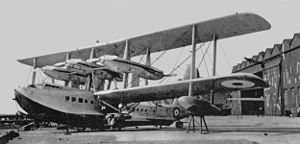| S.14 Sarafand | |
|---|---|
 The prototype and only Sarafand at Felixstowe in 1932. | |
| General information | |
| Type | Flying boat |
| National origin | United Kingdom |
| Manufacturer | Short Brothers |
| Status | Prototype |
| Primary user | Royal Air Force |
| Number built | 1 |
| History | |
| First flight | 30 June 1932 |
| Retired | 1936 |
The Short S.14 Sarafand was a British biplane flying boat built by Short Brothers. It was planned as a general reconnaissance aircraft for military service. When it was built in 1932 it was the largest aeroplane in the United Kingdom.
The Sarafand was first proposed by Oswald Short in 1928 as an enlarged development of the Singapore II, to provide transatlantic range capability. Short managed to persuade first his chief designer Arthur Gouge and then the Chief of the Air Staff, Sir Hugh Trenchard (later Viscount Trenchard) of the feasibility of such a large aircraft and Air Ministry specification R.6/28 was drawn up to define the project. It was conducted as a public/private joint venture, the Air Ministry funding it with £60,000 and Short Brothers providing the rest.[1] The aircraft was originally designated the Short R6/28 before being named the Sarafand.[2]
- ^ Barnes & James, p. 257
- ^ Pearce, William (10 February 2015). "Short S.14 Sarafand Flying Boat". oldmachinepress.com. Retrieved 17 May 2016.